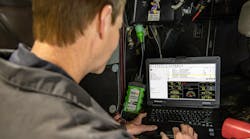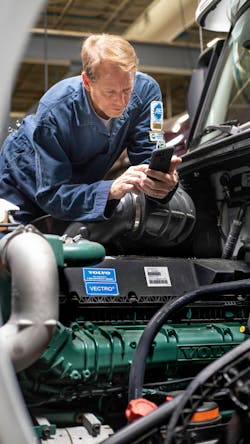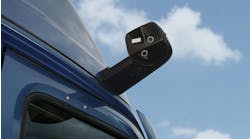The amount of time diesel technicians spend on electronic diagnostics has grown as the number of electronics on Class 8 trucks has increased, and technicians are turning to diagnostic tools to help streamline repairs and increase efficiency within the shop.
“Everything is going electronic and digital. Electronic control modules and electronic control units are showing up everywhere,” said Bruno Gattamorta, vice president of sales and marketing, Cojali USA Inc., which manufacturers the Jaltest Diagnostics tool. “Everything is going to be electronic in a certain element.”
Jason Hedman, product manager at Noregon, a diagnostic repair and data analytic solutions provider, said that on average, trucks manufactured in 2000 contained fewer than three ECUs connected to a vehicle network. Today, the average new truck contains 21 or more.
“This major uptick in ECU count opens the door for more electronic and communication errors, signifying the importance for technicians to be proficient on tools and applications that help them diagnose, troubleshoot, and repair electronic issues,” Hedman said.
The use of electronic sensors has not only grown exponentially, but will continue to increase, said Thomas Kotenko, a general manager for NEXIQ Technologies. “You, in essence, have a moving computer. Everything is signaled through electronics,” he said. “Now, a technician isn’t working on an engine; he is working on a computer.”
Allison Whitney, a spokesperson for Autel, a developer of intelligent diagnostics, detection, and analysis systems, said scan tools have become essential to repairing and servicing vehicles as electronic sensors and components manage multiple systems within the truck.
“Most shops will perform a quick triage-like scan as soon as the vehicle enters the bay door and before the hood is popped, just to get a quick idea of the extent of the issues they are dealing with. Without a diagnostic tool, it’s a total guessing game, and techs would need to swap out parts in the hope that they are replacing the right one,” she said.
What’s more, Gattamorta said fixing electronic issues is more complicated than replacing a component that failed. “When you look at wires, there are probably 100 yards in Class 8 trucks,” he said. “You have to start navigating the wire. Is there interference? Is it a short circuit? Wiring is set up in blocks so you can segment by areas, but as you can imagine, you still have to go in with a detective cap and figure out where the cable went wrong.”
That is why wiring diagrams can be so helpful, but an OEM wiring diagram could take up a whole wall in a conference room, Gattamorta said. The Jaltest Diagnostics tool has a wiring diagram for the entire truck. “It shows you how everything connects to each other and how you go from system A to system B. You can see the wiring diagram, see the cables, and how they’re connected to the pins,” he said, adding the information can simplify repairs.
Hedman said trucks have become too complex to simply rely on a code reader and a wrench to diagnose and repair an issue. Today’s technicians must be proficient in multimeters, refractometers, and other handheld tools, he said.
“Consider the rise in pending faults since the advent of EPA 10 engines. Technicians can’t rely on dash lamps and active fault codes if they expect to dispatch a healthy truck. Diagnostic tools that show pending faults allow proactive repairs to be made, so issues don’t arise when the truck is on the road,” Hedman said.
With Noregon’s JPRO’s Data Monitor, technicians can chart data points across multiple ECUs to help discover wiring or communication issues. “This helps technicians discover the general area of a communication failure and use a wiggle test, multimeter, or other method to pinpoint the exact wire or sensor causing the issue,” Hedman said.
Increased use of electronics is also placing a more significant strain on batteries, and Whitney said battery analysis tools have become necessary as the modern vehicle evolves. “Just consider how much is expected of the vehicle battery with systems such as stop/start ignitions and the expansive safety and infotainment systems,” she said.
Autel’s line of starting and charging analysis tools helps technicians analyze the three components that comprise the starting and charging system—the battery, the starter, and the alternator—giving a clear and concise analysis of each system along the way, Whitney said. The MS909CV now comes with a battery analyzer accessory tool so new tests can be performed wirelessly through the tablet tool. Technicians can test the battery or electrical system components individually.
Duane Watson, technical trainer for Bosch Aftermarket Service Solutions, said knowing the battery voltage is as important as reading codes at the time of vehicle diagnosis. Bosch has built a voltage gauge in its OBD-II diagnostic tool on all of its ADS scan tools. “These scan tools can be paired with a BAT 120 battery tester. It allows the scan tool to be a full-blown battery tester and electrical system diagnostic tool,” he said.
Hedman said many technicians are visual learners, so the JPRO tool interface presents graphics that are easy to understand. “For example, the visual display during a battery diagnosis in JPRO contains a large graphic consisting of key data points in their respective areas, helping technicians quickly learn which items are out of range,” Hedman said.
Whitney said that scan tools themselves have advanced significantly as equipment technology has advanced. “Our tools show freeze frame data for each of the codes that can show the technician what was happening prior to the code be setting off,” Whitney said. “The ability to perform active tests on components is another vital feature.”
Advanced tools translate into improved diagnostics. “As technicians like to say, codes tell on one another, and often one code begets another, and the tech needs to go deep and find what is the root of the initial and subsequent codes,” Whitney said. “That’s where the active component testing becomes an essential feature of a good diagnostic tool.”
One of the trucking industry’s greatest challenges is the technician shortage, so shops need to maximize technicians’ time, Kotenko said. “Rather than using the old school method of obtaining a trouble code, technicians can use a scan to be more efficient,” he said. “The time savings would at least be one- to 10-fold.”
Technicians simply can’t compete with the efficiency of a diagnostic tool when trying to repair electronic issues, Hedman said, and tools help technicians find the exact location of a failure, resulting in a much more streamlined process.
Gattamorta said diagnostic tools can guide diesel techs through the repair, which can be helpful for techs not familiar with a particular piece of equipment and can speed repairs for even seasoned technicians.
This article originally appeared in Fleet Maintenance.




